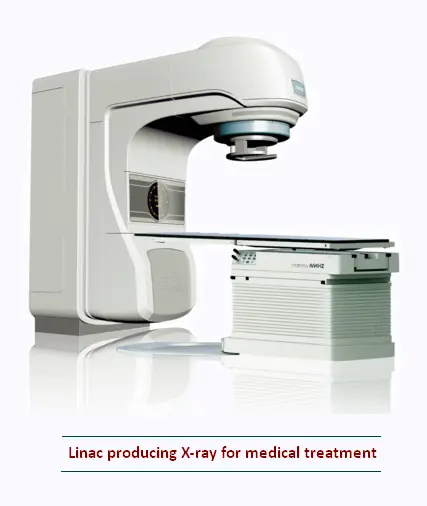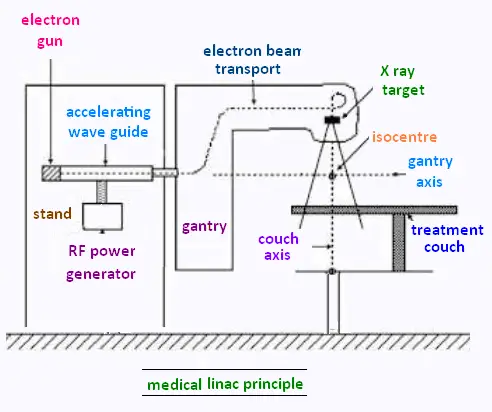Nuclear Physics
The nucleus
Radioactivity
Applications
Particle accelerators
© The scientific sentence. 2010
|
Nuclear Physics &
Particle Physics
Particle accelerators
Linear accelerator
Linear accelerator

In a linear accelerator : LINAC , an ion is injected into an accelerating tube containing
a number of electrodes. A high-frequency alternating voltage from an oscillator is
applied between groups of adjacent cylindrical electrode tubes.
An ion traveling down the tube will be repeatedly accelerated across the gaps in the gap
between the electrodes. By the time the particle reaches the next gap the polarity of
electric field has reversed and so the particle is accelerated once more.
In a linear accelerator (LINAC) the charged particles are accelerated in a straight
line (whereas in a circular accelerator magnetic fields are used to move the particles
in a circular trajectory ).
LINACs have an important advantage over circular accelerators. When a charged particle
is moved in a circular path it radiates energy (synchrotron radiation) so that a lot of
the input energy is wasted. There is no such waste in a linear accelerator.
However, the length of a LINAC limits the energy achieved.
One of the most powerful linear accelerators is located at the Stanford
Linear Accelerator Centre, California, called SLAC. This accelerator is 3km long
and accelerates electrons and positrons up to an energy of 50 GeV.
Medical linear accelerator

A LINAC is the device most commonly used for external beam radiation treatments
for patients with cancer.
It is used to treat all parts, and organs of the body. It delivers high-energy x-rays
to the region of the patient's tumor. These x-ray treatments can be designed in such a
way that they destroy the cancer cells while sparing the surrounding normal tissue.
The first clinical use of a linear accelerator was in the mid 1970s.
Today more then 4,000 accelerators are in use for radiotherapy around the world.

The medical linear accelerator accelerates electrons in a part of the accelerator
called the wave guide. Then, these electrons collide with a heavy metal target.
As a result of the collisions, high-energy x-rays are produced from the target.
These high energy x-rays are shaped as they exit the machine to conform to the shape of
the patient's tumor.
The patient lies on a moveable treatment couch and lasers are used to make sure the patient
is in the proper position. The treatment couch can move in many directions. The beam comes out
of a part of the accelerator, which can be rotated around the patient.
Radiation can be delivered to the tumor from any angle by rotation and
moving the treatment couch.
 The first linear accelerator was built in 1928 by Rolf Wideroe
(1902 – 1996), a Norwegian accelerator physicist. It accelerated positive ions
to about 50 keV.
The first linear accelerator was built in 1928 by Rolf Wideroe
(1902 – 1996), a Norwegian accelerator physicist. It accelerated positive ions
to about 50 keV.
The method of particle acceleration
in a linac was invented by Leo Szilard (1898 - 1964), a hungarian-american
physicist and inventor; that conceived the nuclear chain reaction in 1933.
|
|